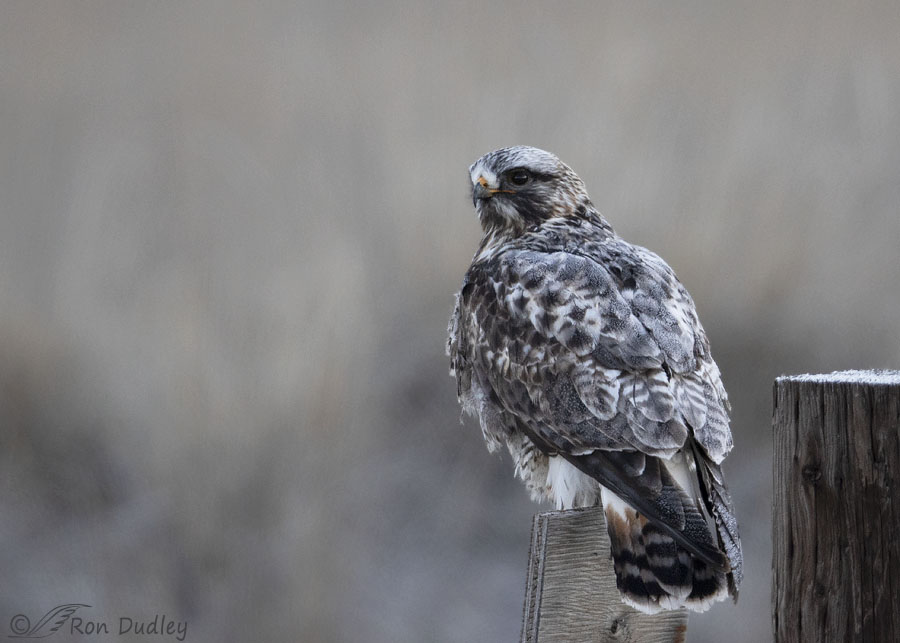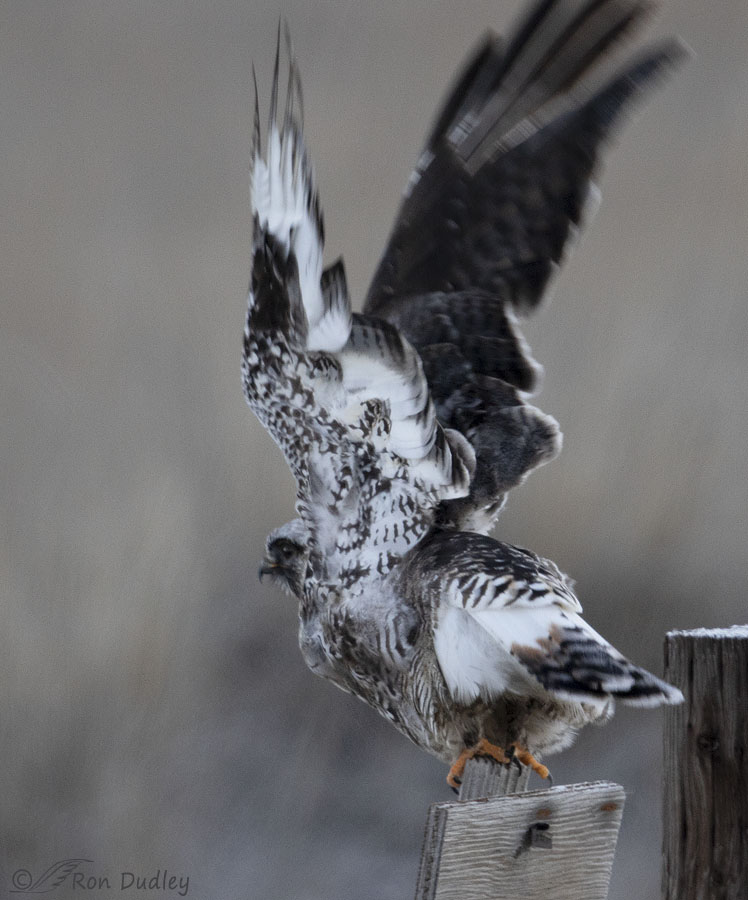And a minor mystery solved.

1/500, f/5.6, ISO 800, Canon 7D Mark II, Canon EF 500mm f/4L IS II USM + EF 1.4 III Extender, not baited, set up or called in
Three days ago just before sunrise at Bear River MBR I had this Rough-legged Hawk, likely a male, in my viewfinder for less than 10 seconds before he took off from an old and weathered plywood sign.
Typically I don’t stop for birds when I find them before the sun comes up but I made an exception for this guy because many of his dorsal surfaces were covered with frost which, despite the poor light, I thought might make for some interesting photos. Only minutes before I’d noticed that it was 10° F. so I couldn’t help but have empathy for the frosty hawk.
Notice the frost on top of the post on the right. As an arctic species Rough-legged Hawks are used to such temperatures, but still. I had my seat warmers cranked up and a heavy coat over my lap and legs and I was still cold. Since I left Montana and since I reached old fart status I’ve become a real wuss in cold weather.
While I was processing the photo I noticed something puzzling. What was he actually perched on? If he was perched atop the edge of the sign we should be able to see the rear toe (hallux) of his left foot wrapped back and over the top of the sign but we can’t. Besides, he appears to be perched a little too far forward and low for his feet to be on top of the sign. Was there something that we can’t see attached to the other side of the sign that he was perched on?
So I went back to look at my takeoff shots to see if I could find an answer. I’d almost deleted those photos the moment I saw them because he took off away from me and with my slow shutter speed in the low light they were horribly soft.
I’m glad I hadn’t. Sometimes soft photos can still be revealing.

He’d actually been perched on the top of the small post that supported the sign.
He’d just been hunkered way down so his feathers would keep his feet warm. Rough-legged Hawks, along with Ferruginous Hawks and Golden Eagles, are the only North American raptors to have feathered legs but their feet are featherless and vulnerable to the cold.
That’s where the name “Rough-legged” comes from – their feathered legs.
Ron
Correction:
In my post I said that Rough-legged Hawks are “used to such temperatures”, referring to the 10° F. temperature that morning. But my good friend Jim DeWitt (Wickersham’s Conscience) corrected me. And Jim should know since he lived in Alaska for most of his life and he knows his birds. Here’s Jim’s correction.
“Rough-legged may be arctic breeding, but they make a point of arriving there after it has warmed up there and their prey – arctic ground squirrels, tundra voles and other rodents – have emerged from hibernation. I’d be surprised if any Rough-legged saw 10° on breeding territory. Freezing, yes, but unlikely that far below freezing.”


Thank you for your interesting post and neat photos of this beautiful rough-legged hawk, Ron. Although they may not breed in temperatures this cold, I frequently see them living for part of their migration cycle in very cold areas, like the San Luis Valley in Colorado where it often gets much colder than 10 deg F. It baffles me why they migrate to places like this in the winter, it may be “warmer” at this time of year, and have more daylight, than the high arctic, but why not keep on flying south to Cancun for the winter ;-). ?
Thanks, Ed. Migration routes and timing can sure be hard to figure sometimes.
Ron, I look forward to your posts every day and read them most days. I continue to learn much about birds and wildlife photography. I rarely comment, but I thought that you would be interested in some validation of a few of your prior comments about heat distortion from lens hoods in cold weather. The following link is to a YouTube video by Steve Perry who observed the same thing and did a variety of tests with different camera and lens to demonstrate the effect: In case you are not familiar with Steve Perry, like you, he is an outstanding wildlife photographer. He’s also the best wildlife photo educator that I’ve come across. Anyway, I thought you would be interested in the video since it clearly proves your observations and comments.
https://youtu.be/B42nXgYUwyo
Thanks for the link Steve. I watched it twice.
Being suspicious of this very possibility I shot without my hood for part of several mornings last month but each time my photos were still soft. But now I’m curious enough to try it again.
Just looking at all that frost makes me cold. I continue to marvel at the physiological and behavioral adaptations that all these critters (and other living things) have for making it in such frigid temps. Before your takeoff shot reveal, I was imagining that he was sitting with one foot tucked up in his feathers for warmth and then shifting feet when the one on the sign got too cold. Glad he was able to keep both tootsies warm(ish).
” I was imagining that he was sitting with one foot tucked up in his feathers for warmth”
Before he took off I suppose it’s possible that you were right, Marty, But of course he put both feet down to take off so that’s what we see in the second photo.
He’s a beautiful frosty specimen! And being one who can barely tolerate temps below 50F anymore (after living in Wyoming for several years), I have great sympathy for his and your frozen appendages on this day. 🥶
Chris, living in Wyoming I suspect you also had to be pretty tolerant of wind. Personally I dislike persistent wind even more than extreme cold.
I am sooooo glad that you were able to solve the mystery. I am a lover of cold but even I have my limits.
Years back when we lived in a colder part of Oz (all relative I know) a motor cycle was our only form of transport. Coming home in the early morning frost often settled on our thighs and our hand were too chilled to easily remove our helmets…
That is a beautiful bird and I am glad that his britches are useful as well as stylish.
You are, or at least were, pretty tough when it comes to cold, EC. Even when it’s fairly warm riding a motorcycle can be a chilling experience unless you’re really dressed for it.
We were poor students at the time. We weren’t dressed for it. A pair of jeans does not protect you from the frost (or the road if it comes to that).
Very cool photo (pun intended). I admit I had to zoom in to see the ice crystals. Oddly, the first thing that came to mind was petechia. Except white instead of red.
It’s amazing to think that RLH’s and other raptors can hunt in those temperatures. I’d need well insulated gloves and hand warmers to do much of anything, much less perch on a post.
“It’s amazing to think that RLH’s and other raptors can hunt in those temperatures”
Or to think that there’s prey out and about for them to hunt. If I were a little rodent I’d be hunkered down in my burrow/nest.
The frost on his back makes me feel the cold. As you have mentioned in the past, its difficult to get such clear photos when its that cold becomes of the effects on the camera lens, and the camera. Thanks for getting and sharing one.
Thanks, Kent. This photo is a little soft for exactly the reason you mention. But it isn’t bad.
Very unique shot of this frosty fella!
Thank you, Kathleen.
Such a satisfying solution to a puzzling perch picture – the takeoff tells all.
Thanks, Frances.
Beautiful with the frost on it’s back tho gives me a shiver (+8 here at the moment so I can relate). Seat warmers and lap cover don’t do much for the fingers and face tho! 😉 Guess the little post would allow it to better cover it’s feet. His mottled coloring in the 2nd shot does indicate how well he could “blend in” should he want to.
“Seat warmers and lap cover don’t do much for the fingers and face tho”
Or the toes, Judy. Because of nerve problems in my feet I can’t wear regular shoes so I have to wear sandals. I’m glad none of my toes froze and dropped off…
Wow. That pair of photos is so illuminating. Thank you.
Thank you, Cheryl.
So glad you stopped to get these shots. To me that is a beautiful photo. How often do you get a chance to get a hawk covered in frost. Very educational too regarding the talons/feet etc. Definitely would have assumed it was perched on that sign if you had not gotten the following photos. Surviving in nature is a daily battle that often takes down these beautiful creatures we so much enjoy. We are all wusses compared to courageous birds like this guy.
Good to know I’m not a wuss all by my lonesome!
Brrr indeed! I am continually amazed at the adaptations Nature’s provided Her children.
Arwen, what I keep thinking about birds in winter is… How do they survive the long nights in that intense cold? I pretty much know the answer but it’s still quite a feat.